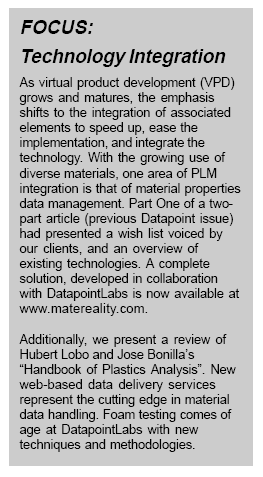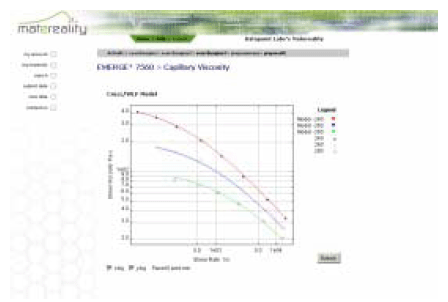
Fig 1. Matereality DDS can store
and deliver data of high complexity, as this viscosity data for
EMERGE* 7560. *Trademark of the Dow Chemical Company)
DatapointLabs clients who wish to receive test results via Matereality®
DDS during the trial period must set up an account by registering
at www.matereality.com.
Access to Matereality® remains free to DatapointLabs
clients during the trial three month period.
All accounts will be created within the DatapointLabs Domain and
will share its default data access policies as follows:
Private: only users designated by the account owner can view the
test results.
Visible: Matereality® users can see that data exists,
but must request permission to access and view test results.
Clients will have full control to set the access permissions for
their data. They can at will change the visibility status of their
data to Public (visible and accessible to all) or Hidden (Private
and invisible to all), depending on their business needs.
Clients may also elect to have their own Matereality®
Domain for complete MDM (see page 3 for more details). In this case,
DatapointLabs will deliver the data directly into the Client’s
MDM Domain.
Material Data Management Goes Beyond
Material Selection -Part 2
With a multitude of modern materials in use today, users of material
properties across OEMs, Tier 1-n suppliers, aerospace, defense,
resin manufacturers and high technology industries are all facing
the technological challenge to store, manage and seamlessly exchange
diverse material property data. Existing technologies that have
been used to handle material properties were originally created
to serve as material selection tools. They were populated as large
repositories of comparative material properties. Some of these are
now being adapted as material data management (MDM) systems, but
lack capabilities for storage and management of diverse representative
properties of interest for virtual product development (VPD).
Part 1 of this article (previous issue), highlighted the needs of
the VPD community with regard to “materials issues”.
It showed that storage and representation of multipoint and interdependent
material behavioral characteristics of interest for VPD demands
a system that can handle diverse collections of traceable, application-specific
properties ranging from simple linear to complex nonlinear data.
Data may need to be public or private depending on the business
needs of the owner. This follow up article introduces a new technology,
Matereality® that has been developed to meet these
needs.
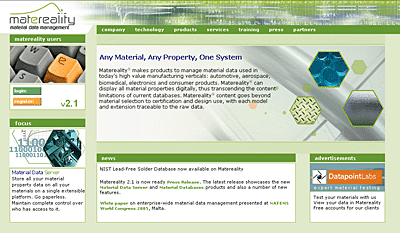
Fig 2. The Matereality®
Material Data Management Portal
Matereality® accommodates a variety of materials,
including plastics, rubber, foams and metals. It stores raw data,
as well as properties derived from the measurements. Matereality®
allows diverse output formats ranging from plots and numerical data
to CAE material model parameters enabling the material data to be
used in the appropriate format, wherever in the product life cycle
the need may be. Further, Matereality® allows traceability
of data to its original source including test details, creating
a single paperless electronic repository which acts as a definitive
storage for all material property data.
Matereality® is designed for companies that work
with a variety of materials and seek to securely store and share
their material data across a distributed development platform of
internal users and external collaborators. Material suppliers can
publish or selectively distribute their data instantly across the
globe. Submission of materials to client companies for certification
by large OEMs becomes automatic and effortless. CAE companies can
leverage Matereality® to pipein application-appropriate
data models seamlessly, enhancing ease of use and design confidence.
Material testing companies such as DatapointLabs have begun using
Matereality® Data Delivery Service. Matereality®
is thus pre-populated with highly relevant material properties,
providing immediate and valuable content for VPD.
-Renu Gandhi.
Part 1 of
this article featured in Datapoint Winter 2003 issue.
It can be accessed at www.datapointlabs.com/newsletter
Handbook of Plastics Analysis
The definitive desktop companion for
anyone engaged in the testing and analysis of plastics or in the
use of properties developed from polymer analysis.
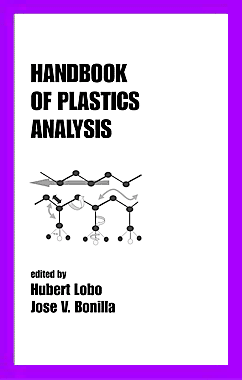
ISBN: 8-8247-0708-7
Publisher: Marcel Dekker, Inc.
270 Madison Ave, New York, NY 10016
Phone: 212-696-9000
Assurance of quality in raw materials, control over production,
and a basic understanding of criteria for performance all require
a sure and complete knowledge of analytical methods for plastics.
The present volume organizes the vast world of plastics analysis
into a relatively compact form. A plastics engineer will find familiar
territory in such subjects as rheometry, differential scanning calorimetry,
and measurement of thermal properties. Polymer physicists and chemists
will be at home with spectroscopic analyses, liquid chromatography,
and nuclear magnetic resonance. All these topics and many more are
covered in twelve chapters written by an impressive array of experts
drawn from industry and academia.
Perhaps the main message to be taken from this work is that the
day of laboratory tinkerers and home-built machines seems to have
come to an end. There was a time when reasonable shop facilities
and a few inexpensive instruments would suffice to answer most questions
for the plastics producer, supplier or customer. As described in
this book, accurate, meaningful measurements of properties today
invariably call for great precision in machinery as well as sophisticated
computing and interpretation, none of which comes cheap.
In research as in production, time and equipment represent precious
components of any budget. Unneeded or redundant analyses can be
avoided when the whole world of analysis is surveyed. A thorough
understanding of the limits and possibilities of each of the methods
described here will allow the user to get the maximum return on
investment whether it is in computers, instruments, analytical services,
or laboratory time.
-Ferdinand Rodriguez is Professor
Emeritus, School
of Chemical and Biomolecular Engineering, Cornell University
New Capabilities Widen Expertise
DatapointLabs has successfully developed a core
competency in the measurement of properties of foam materials. In
a series of initiatives, methodologies have been created and validated
to make quantitative tensile, compressive and Poisson’s Ratio
measurements.
The high speed compressive test method was refined to extract rate
dependent stress-strain behavior.
A new technique was developed to measure bulk compressibility of
foams using a confined compression method.
Such data have been primarily applied to the modeling and simulation
of foam behavior in structural and impact simulation areas. The
techniques have been applied to porous, crushable and elastomeric
foams. Good success has been reported by clients.
Accreditation to ISO/IEC 17025
DatapointLabs has successfully renewed its accreditation with the
American Association of Laboratories Accreditation (A2LA) to the
new ISO/ IEC 17025 for all the tests listed in its new scope which
can be viewed at: www.datapointlabs.com/qualitysystem.asp
“A significant effort was devoted to the development of uncertainty
budgets. This adds a whole new level of confidence to the reliability
of the test data generated by our laboratories” says Hubert
Lobo, Company President.
The re-accreditation is valid through February 2005. In addition
to maintaining and renewing the accreditation status,
DatapointLabs has an ongoing effort to add new tests to its A2LA
Scope of Accreditation. The latest addition is:
ISO 37 Rubber-Determination
of Tensile Stress Strain Properties
-Craig Montoya, Quality Manager
Foam Models for DYTRAN & LS-Dyna
Working with MSC.Software, DatapointLabs has
successfully developed the capability to model foams in the MSC.Dytran
product.
At this time, the Foam2 Model for isotropic elastic foams with user
specified hysteresis response is available as a TestPak®.
This enhancement is judged to be important in the modeling impact
and recovery of foams that suffer damage.
The LS-Dyna MAT63 Crushable Foam Model is now available along with
rate dependencies to accommodate impact situations.
Upcoming Events
ISO TC 61, Maastricht,
Netherlands, Sept. 28-30, 2003.
MSC.Software’s Virtual Product
Development Conference, Dearborn, MI,
Oct.13-15, 2003.
ASM Materials Solutions Conference,
Pittsburgh, PA, Oct.13-15, 2003.
EuroPAM,
Mainz, Germany, Oct. 16-17, 2003
TestingExpo2003 NA,
Novi, MI, Oct. 29-31
CAD-FEM Users’ Meeting,
Potsdam, Germany, Nov. 12-14, 2003
|
|
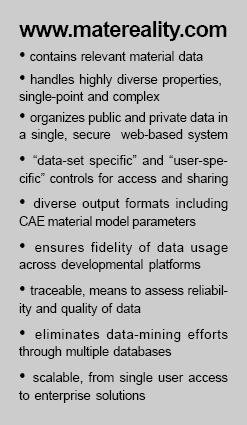
|


